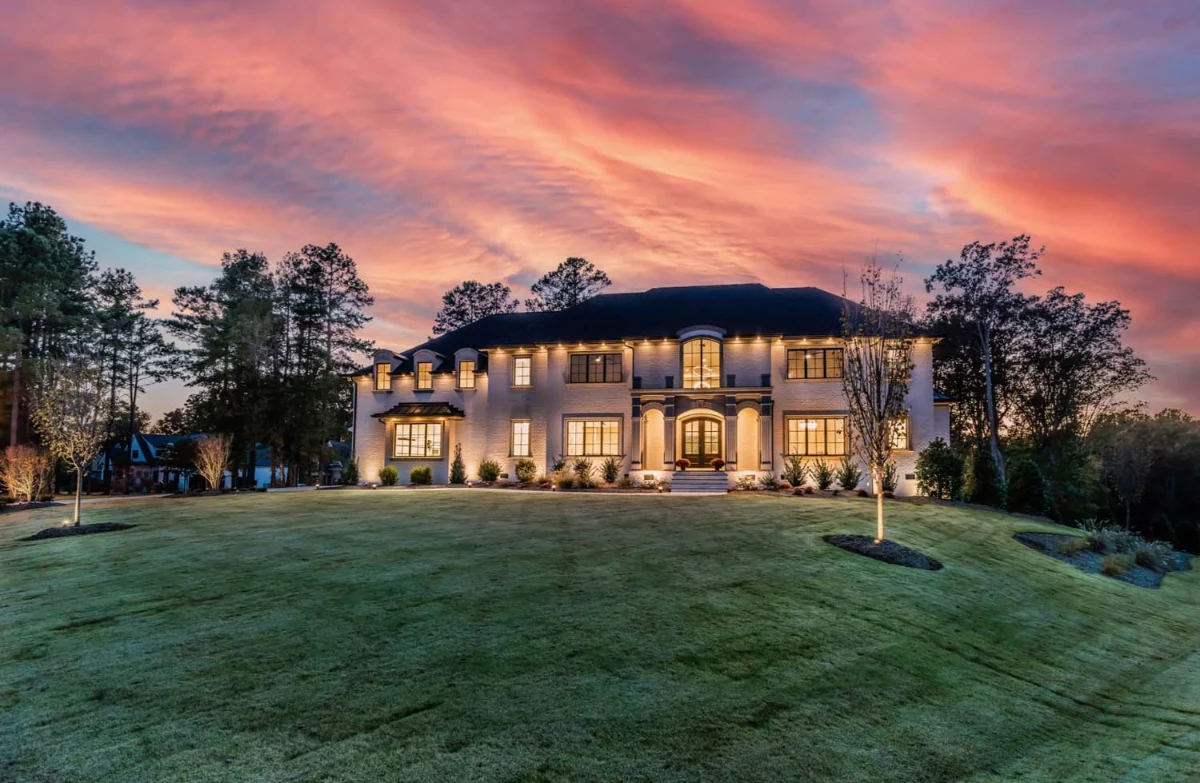The best insulation for a custom home is the one that balances high R-values, cost efficiency, and climate compatibility, because even the most beautiful house can be uncomfortable without the right thermal envelope. According to the U.S. Department of Energy, proper insulation can cut heating and cooling costs by up to 20%.
At Hafsa Building Group, we help you choose materials that not only meet energy performance targets but also align with your home’s design and your local building codes. Since 2017, our team has built homes across North Carolina with a focus on craftsmanship, transparent communication, and a process that reflects your vision.
Key Takeaways
- Highest R-values come from closed-cell spray foam and polyiso foam board
- Fiberglass batts are the most affordable option for general use
- Closed-cell spray foam is best for humid climates
- Spray foams and dense-pack cellulose require professional installation
What Makes Insulation “Best” for a Custom Home?
The best insulation for a custom home is the one that meets your climate needs, fits your budget, and keeps energy bills low for decades.
When Hafsa Building Group plans insulation for a new build, we look at three core factors:
- Thermal Performance (R-Value) R-value measures how well a material resists heat flow. Higher numbers mean better insulating power. The ideal R-value depends on your home’s location and the part of the house being insulated. For example, an attic in North Carolina’s climate zones often calls for R-38 to R-60, while walls may need R-13 to R-21.
- Climate Suitability Materials respond differently to humidity, temperature swings, and seasonal weather patterns. Closed-cell spray foam, for instance, handles moisture well, making it a strong choice for humid summers, while fiberglass batts are cost-effective for dry, conditioned spaces.
- Installation Quality Even the highest R-value material underperforms if poorly installed. Gaps, compression, and moisture issues can cut insulation performance dramatically, which is why we prioritize skilled, code-compliant installation on every project.
By weighing these factors together, rather than just chasing the highest R-value or the cheapest cost, you get insulation that works for your custom home’s design, climate, and budget.
Insulation Types Compared: R-Values, Costs, and Climate Suitability

The table below compares the most common insulation types for custom homes, using national averages from the U.S. Department of Energy and other trusted sources. All costs are installed prices per square foot and may vary based on home design, location, and labor rates.
| Insulation Type | R-Value per Inch* | Installed Cost / sq ft | Best Locations | Climate Zone Fit | DIY vs Pro |
| Fiberglass Batts / Rolls | 2.9 – 3.8 | $0.60 – $1.00 | Walls, floors, attics | Zones 3–8 | DIY possible, pro recommended for fit |
| Fiberglass Loose-Fill | 2.2 – 2.9 | $0.75 – $2.25 | Attics, hard-to-reach cavities | Zones 3–8 | Pro recommended |
| Cellulose (Loose-Fill) | 3.2 – 3.8 | $0.75 – $2.25 | Attics, walls (dense-pack) | Zones 3–8 | Pro only |
| Mineral Wool (Batts/Loose) | 3.0 – 3.3 | $1.40 – $2.10 | Walls, floors, basements | Zones 3–8 | DIY possible with PPE |
| Open-Cell Spray Foam | 3.5 – 3.6 | $1.70 – $2.50 | Walls, ceilings, attics | Zones 1–8 | Pro only |
| Closed-Cell Spray Foam | 6.0 – 7.0 | $1.30 – $2.00 (per inch) | Walls, roofs, crawl spaces | Zones 1–8 | Pro only |
| Polyiso Foam Board | 6.0 – 6.5 | $0.60 – $0.70 | Foundations, exterior walls, roofs | Zones 3–8 | DIY possible |
| Radiant Barrier | N/A** | $0.10 – $0.95 | Attics (hot climates) | Zones 1–3 | DIY possible |
| Vapor Barrier / Retarder | N/A | $0.25 – $0.50 | Crawl spaces, basements, walls | Depends on moisture risk | DIY possible |
*R-value per inch based on DOE and NAIMA data.
**Radiant barriers reflect heat rather than resist conductive/convective heat flow, so they don’t have a traditional R-value.
6 Types of Insulation for Custom Homes
Different insulation materials have unique strengths, costs, and best-use scenarios. Here’s a closer look at the most common options for custom home builds, including how each performs in North Carolina’s climate.
1. Spray Foam Insulation
For homeowners who want maximum air sealing and high thermal performance, spray foam is often the gold standard. It comes in two main types:
- Open-cell: Softer and more flexible, with an R-value of 3.5–3.6 per inch. Ideal for sound control and filling irregular cavities, but with lower moisture resistance.
- Closed-cell: Denser and more rigid, with an R-value of 6.0–7.0 per inch. Acts as a vapor retarder, making it a strong choice for humid climates like North Carolina.
Hafsa Insight: We recommend closed-cell in areas prone to moisture and open-cell where sound control and flexibility are higher priorities. Proper installation by trained professionals is critical to avoid uneven curing and off-ratio foam.
2. Fiberglass Insulation
Fiberglass remains one of the most widely used insulation types thanks to its affordability and versatility. Available in batts, rolls, and loose-fill, it can be adapted to a variety of spaces in a custom home.
Batts and rolls have an R-value of 2.9–3.8 per inch, while loose-fill is slightly lower at 2.2–2.9.
Fiberglass is a strong option for attics, walls, and floors, but performance drops sharply if gaps or compression occur. We confirm a precise fit for full thermal benefit.
3. Cellulose Insulation
If sustainability is a top priority, cellulose made from recycled paper and treated with fire retardants is worth considering. It provides a dense layer of coverage that slows air movement.
With an R-value of 3.2–3.8 per inch, cellulose performs well in both attics and dense-packed wall cavities.
At Hafsa, we value cellulose for its eco benefits and sound control, but in new builds we manage settling risk and moisture control for long-term performance.
4. Mineral Wool (Rock Wool)
For homeowners prioritizing fire resistance and soundproofing, mineral wool offers a dependable solution. It’s denser than fiberglass and naturally moisture-resistant.
R-values range from 3.0–3.3 per inch.
Ideal for interior partitions and between floors, mineral wool adds both safety and quiet to a custom home design.
5. Foam Board / Rigid Foam Panels
Rigid foam boards such as EPS, XPS, and Polyiso are best known for continuous insulation, which helps prevent heat loss through framing.
Polyiso has one of the highest R-values per inch (6.0–6.5), making it effective for exterior sheathing, foundations, and roof decks.
For high-performance homes aiming for energy certifications, continuous rigid foam insulation is one of the most effective upgrades.
6. Radiant Barriers & Vapor Barriers
Some insulation-related products don’t trap heat, they manage it in other ways. Radiant barriers reflect radiant energy, while vapor barriers control moisture migration.
Radiant barriers have no R-value but can reduce attic temperatures by up to 30°F in hot climates (zones 1–3).
In North Carolina, radiant barriers can be helpful in sun-exposed attics, but vapor barriers are essential in crawl spaces to protect the structure from moisture damage.
How to Choose the Right Insulation for Your Climate Zone

North Carolina falls primarily in IECC Climate Zones 3 and 4, which are considered mixed-humid. This means summers are hot and humid, winters are moderate, and year-round moisture management is important.
Below is a simplified guide to the DOE-recommended R-values for homes in these zones, along with insulation types best suited for each application in a custom home build.
Why Climate Zones Matter
A high R-value doesn’t automatically mean the insulation is right for your home. Materials behave differently depending on humidity, temperature swings, and air movement patterns.
In North Carolina’s climate, moisture control is just as important as thermal resistance. This is why Hafsa Building Group often recommends closed-cell spray foam for below-grade and vented spaces, while still using fiberglass or cellulose in drier, conditioned zones.
DIY vs Professional Installation
Some insulation projects are within reach for experienced DIYers, but in a custom home build, professional installation often delivers better performance, code compliance, and long-term durability.
When to Call a Pro
Custom home projects almost always require professional insulation work because the stakes are higher and the details matter. A professional allows for:
- Proper R-Value Installation: Achieving full depth and coverage without compression or gaps
- Air Sealing Integration: Combining insulation with air and moisture control layers for maximum efficiency
- Code Compliance: Meeting North Carolina’s IECC requirements for climate zones 3–4
- Moisture Management: Correct placement of vapor retarders and preventing condensation issues
- Specialty Materials: Spray foam, dense-pack cellulose, and mineral wool often require specialized equipment and safety protocols
At Hafsa Building Group, we handle insulation as part of an integrated building envelope strategy just “filling cavities.” This means we coordinate with framers, HVAC installers, and drywall crews for a smooth process.
Rebates, Incentives, and ROI
The right insulation not only improves comfort, it can also pay for itself over time. Between lower energy bills and available rebates, homeowners in North Carolina can often offset a large portion of their upfront investment.
North Carolina Incentives
The Energy Saver NC rebate program, funded through the Inflation Reduction Act, has allocated over $208 million for residential energy upgrades. Insulation projects can qualify for up to:
- $1,600 for insulation and air sealing under the High-Efficiency Electric Home Rebate (HEAR) program
- $14,000 total for whole-home upgrades through the HOMES program, or up to $16,000 for HEAR if income-qualified
Source: NC Department of Environmental Quality
Federal Incentives
Homeowners can claim a 30% federal tax credit on qualifying insulation projects under the Energy Efficient Home Improvement Credit (Section 25C), up to a maximum of $1,200 per year.
Source: U.S. Department of Energy
Why Hafsa Building Group Delivers Superior Insulation Planning

In custom home construction, insulation is a system that affects comfort, efficiency, and long-term value. At Hafsa Building Group, we integrate insulation decisions into the earliest stages of design so every layer of your home works together.
Here’s what sets our approach apart:
- Tailored Material Selection: We match insulation type to your home’s climate zone, architectural design, and lifestyle priorities rather than using a “one-size-fits-all” solution.
- Full Building Envelope Strategy: Our team coordinates with framers, HVAC installers, and drywall crews to make sure insulation, air sealing, and moisture control function as a single, high-performance system.
- Verified Standards & Best Practices: We follow U.S. Department of Energy and IECC recommendations for R-values and installation methods, with attention to North Carolina’s specific climate needs.
- Hands-On Experience: Founded by Rami Hafsa in 2017, we bring years of direct custom home building and remodeling experience to every project.
We make sure your insulation works in harmony with your home’s design. The result is a quieter, more comfortable, and more energy-smart home that performs for decades.
Insulation That Fits Your Home and Your Goals
The right insulation is an investment in comfort, efficiency, and the long-term value of your custom home. By choosing materials that match your climate, design, and performance goals, you’ll enjoy lower energy bills, a quieter living space, and a home that stays comfortable year-round.
At Hafsa Building Group, we handle insulation as part of a complete building envelope strategy because true performance comes from the way every layer works together. Whether you’re building from the ground up or remodeling a key space, we’ll guide you through every decision with clarity, craftsmanship, and a commitment to exceeding expectations.
If you’re ready to make your dream home as energy-smart as it is beautiful, let’s talk. Contact Hafsa Building Group today to start your build with a team that treats your vision like our own.






